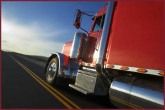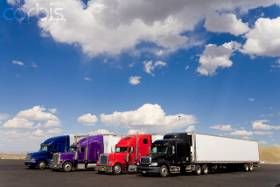Downshifting During Driving Test
Topic 1469 | Page 1
That's fine. At least it was for me. I did the same thing and I never touched the lowest gears. But keep in mind. When you push in that clutch to stop you cant travel too long of a distance with the clutch in before you come to a complete stop. That's points off. They wont expect you to downshift like a pro and they know downshifting in the lowest gears is difficult. So they wont expect you to go from 10 down to 2. What you're doing is fine but watch that distance that you're traveling with the clutch down.
I would try to at least get it into the 5th gear when stopping just to demonstrate that you can somewhat downshift in the low gear. But they definitely don't expect you to be going from 10 all the way down to idle speed.

What they are looking for is that you can downshift during the test, but just knowing how is not all there is. Knowing why you are downshifting and how that downshift affects your truck and load are even more important.
When coming to a stop it is not just about what gear you are in. Its what the engine break is doing. You should have talked about that in class. If you have slowed you truck down to a safe speed then allowing your engine break to take over is what is called "safe stopping."
You know how it feels when you are in say 8th gear coming to a stop and the engine begins to chug? That is your engine break stopping the truck. At that point is where you have the most control. It is at the time you push in that clutch that your control begins to lessen. This is where having experience and being a true truck driver comes into play, because you know what to do next. Apply pressure to your breaks!
In any normal stopping situation the safest control point for a truck is the length of the truck and trailer. So in the gear that you are in, (6th-7th-8th...etc) when engine breaking to that stop, one length of the tractor and trailer to the point of where you are to stop, (white line at a stop sign or signal) is when you want to push in the clutch and coast. No further than that space. You coast no more than the length of the tractor and trailer. They should be teaching you that. It is a very safe measure to be practicing. With or without a load.
You always want to have control of your tractor and trailer. Sometimes you won't like in an emergency situation that you have never encountered, but the more you practice this the more control you will begin to learn to have. It takes time and is not something you learn overnight.
You have just asked a very important question and I am very glad that you have. This shows that you are thinking about what you are doing in that truck. Excellent job!
In downshifting too or up shifting try to start looking at your RPM's and Speed. This does not always hold true but is a good beginning point to help you learn the sound and feel of the engine while shifting. From the speed of 15mph up to 55mph you can ADD the numbers of that speed together to know what gear you should be in. 15mph = 6th gear..25mph =7th gear...35mph=8th gear and so on. 1+5=6...2+5=7...3+5=8...etc..
I hope this helps. Good luck with your test.
OWI:
Operating While Intoxicated

You should downshift to first gear before you try to put the car in motion again. You do not need to downshift during the stop, although you can do so.
Using the engine as a part of the braking system is not a bad technique, however it will wear the clutch down, and brakes are cheaper to replace than a clutch.
You should downshift to first gear before you try to put the car in motion again. You do not need to downshift during the stop, although you can do so.
Using the engine as a part of the braking system is not a bad technique, however it will wear the clutch down, and brakes are cheaper to replace than a clutch.
Don't ever call a truck a car lol! 
Using the engine as a part of the braking system is not a bad technique, however it will wear the clutch down, and brakes are cheaper to replace than a clutch.
Welcome aboard Jasmine!
I wouldn't advise a driving technique based on what will lead to the cheapest maintenance down the road. I'd focus on what is the safest technique to use.
Also, the clutch isn't being worn down when it is fully engaged, which it will be when the Jake Brakes are holding you back. And 99.9% of the drivers float gears so you're not even wearing out the throwout bearing by double clutching when you're downshifting. So really there's no wear on the clutch for most drivers when engine braking and downshifting.
Float Gears:
An expression used to describe someone who is shifting gears without using the clutch at all. Drivers are taught to "Double Clutch" or press and release the clutch twice for each gear shift. If you're floating gears it means you're simply shifting without using the clutch at all.
Double Clutch:
To engage and then disengage the clutch twice for every gear change.
When double clutching you will push in the clutch, take the gearshift out of gear, release the clutch, press the clutch in again, shift the gearshift into the next gear, then release the clutch.
This is done on standard transmissions which do not have synchronizers in them, like those found in almost all Class A trucks.
Double Clutching:
To engage and then disengage the clutch twice for every gear change.
When double clutching you will push in the clutch, take the gearshift out of gear, release the clutch, press the clutch in again, shift the gearshift into the next gear, then release the clutch.
This is done on standard transmissions which do not have synchronizers in them, like those found in almost all Class A trucks.

And 99.9% of the drivers float gears
What is floating gears? Thanks
Floating Gears:
An expression used to describe someone who is shifting gears without using the clutch at all. Drivers are taught to "Double Clutch" or press and release the clutch twice for each gear shift. If you're floating gears it means you're simply shifting without using the clutch at all.
Float Gears:
An expression used to describe someone who is shifting gears without using the clutch at all. Drivers are taught to "Double Clutch" or press and release the clutch twice for each gear shift. If you're floating gears it means you're simply shifting without using the clutch at all.
Floating gears means you're shift gears without using the clutch. In school they teach you to double clutch when you're shifting because the states still test for that, but honestly there's no need to do that at all. You can shift just as well without using the clutch.
Floating Gears:
An expression used to describe someone who is shifting gears without using the clutch at all. Drivers are taught to "Double Clutch" or press and release the clutch twice for each gear shift. If you're floating gears it means you're simply shifting without using the clutch at all.
Double Clutch:
To engage and then disengage the clutch twice for every gear change.
When double clutching you will push in the clutch, take the gearshift out of gear, release the clutch, press the clutch in again, shift the gearshift into the next gear, then release the clutch.
This is done on standard transmissions which do not have synchronizers in them, like those found in almost all Class A trucks.

Mark, when you float the gears , you shift by the RPMS. Say your truck upshifts at 1400 rpms, and downshifts at 1100....then you will learn to shift by rpms. A few things may change your rpms...like how heavy or light your load is, terrain. "back in the day"..(no funnies, Raodkill) it was harder, but with the newer synchronized transmissions, its super easy...You will pick it up really easy...its easier than double clutching !!!
Float The Gears:
An expression used to describe someone who is shifting gears without using the clutch at all. Drivers are taught to "Double Clutch" or press and release the clutch twice for each gear shift. If you're floating gears it means you're simply shifting without using the clutch at all.
Double Clutch:
To engage and then disengage the clutch twice for every gear change.
When double clutching you will push in the clutch, take the gearshift out of gear, release the clutch, press the clutch in again, shift the gearshift into the next gear, then release the clutch.
This is done on standard transmissions which do not have synchronizers in them, like those found in almost all Class A trucks.
Double Clutching:
To engage and then disengage the clutch twice for every gear change.
When double clutching you will push in the clutch, take the gearshift out of gear, release the clutch, press the clutch in again, shift the gearshift into the next gear, then release the clutch.
This is done on standard transmissions which do not have synchronizers in them, like those found in almost all Class A trucks.
but with the newer synchronized transmissions, its super easy...
What??? Newer transmissions are synchronized? I haven't heard that. Four wheeler transmissions have synchronizers in them but tractor trailer transmissions never did - which is why they grind gears if the RPM's and road speed don't match like they need to. Four wheelers can put it in any gear at any time regardless of road speed or RPM because of the synchronizers. I don't think big rig transmissions have synchronizers unless this is a new development.
Here's an article called what is double-clutching? that talks about synchronizers in transmissions.New Reply:
New! Check out our help videos for a better understanding of our forum features

















Preview:








 TT On Facebook
TT On Facebook
I understand that during your driving test they don't want you coasting but do they expect you to go down through each gear? My trainer is clueless when I asked him. I've been trying to teach myself and get better. Depending on the situation I usually go from 10th to 9th or 8th then 7th and 6th and usually come to a stop after 6th. I'm not comfortable in the lower gears. Sometimes if I'm slowing and not stopping I'll get it into 4th or so like going into a truck stop but not having to stop.
Is this ok? Are you just showing you can downshift, or are there specific things they are looking for you to do?
OWI:
Operating While Intoxicated